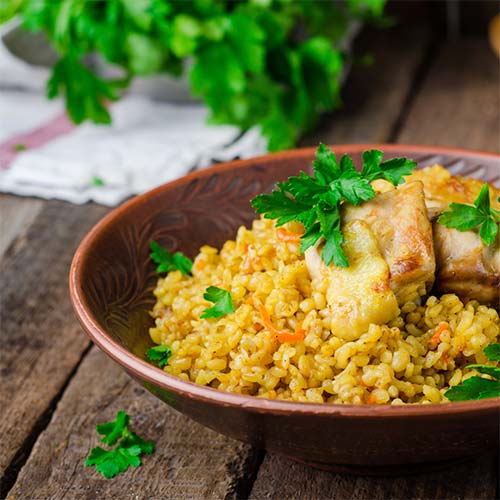Bulgur is best known as the main grain in tabbouleh.
 Background
Background
- Bulgur, also known as bulgur wheat, is a member of the Poaceae botanical family.
- Bulgur is a form of wheat that has been cleaned, boiled, dried and coarsely ground, and then sorted by size. This allows it to be cooked quickly or prepared without cooking.
- It is commonly used in Middle Eastern and Mediterranean dishes for its nutty flavor and chewy texture when cooked.
Nutrition
- Cooked bulgur is a good source of fiber, magnesium, phosphorus, niacin, and an excellent source of manganese.
- Fiber aids in normalizing bowel movements, lowers cholesterol levels, and supports a healthy weight.
- Magnesium assists in blood pressure regulation, bone formation, hormone secretion, and immune function.
- Phosphorus supports bone formation, energy production, and hormone storage and activation.
- Niacin converts food into energy and supports nervous system function.
- Manganese promotes carbohydrate, protein and cholesterol metabolism, the formation of cartilage and bone, and wound healing.
How to Purchase, Prepare, and Store
- Purchase bulgur year round at grocery stores.
- Prepare bulgur by soaking — mix 1 cup of bulgur with 2 cups boiling water and let sit for 60 minutes before enjoying. You can also prepare bulgur by bringing 2 cups water to a boil, adding 1 cup bulgur, reduce heat and simmer for 15 minutes or until water is absorbed. Strain out any excess water.
- Add bulgur to soups, casseroles, salads, or ground meats.
- Store bulgur in an airtight container out of direct sunlight for up to six months.
Nutrition Facts
1 cup bulgur, cooked
- Calories: 75.5
- Protein: 2.8 g
- Fat: 0.21 g
- Carbohydrate: 16.9 g
- Fiber: 4.0 g
- Calcium: 9.1 mg
- Iron: 0.87 mg
- Magnesium: 29.1 mg
- Phosphorus: 36.4 mg
- Folate: 16.4 µg
- Vitamin A: 0 µg
Via fdc.nal.usda.gov
Recipes
Request an Appointment